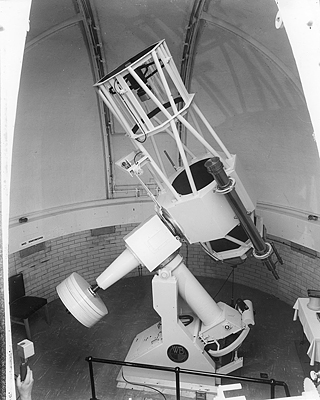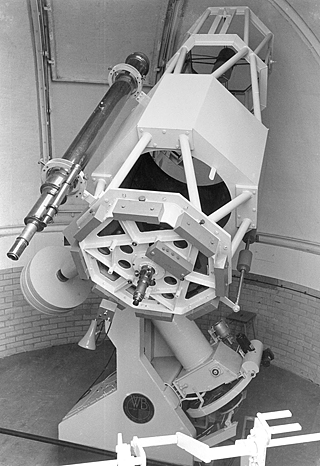1970s
The early 1970s saw a significant expansion in the Observatory. A new dome was built and a 24-inch (0.6 metre) reflecting telescope installed in it. This was called the Thornton Telescope to honour Harry Thornton, whose generous gift had lead to this development. The optics were constructed by Astronomical Equipment (chief optician Jim Hysom) and were designed to be used at Cassegrain focus, though mirror sets were also supplied for primary (Newtonian) and Coudé focus. [Since 1991, the telescope was used at prime focus (f 4.5), with electronic imaging.]
One of the most important benefactors of the Observatory was William Boulton, a local engineering firm. Some of its employees had come into contact with Ron and the Observatory through the evening classes. Along with the Astronomy Society and members of the evening classes, they put a lot into the Observatory's development. The new building is largely down to them, as is the sturdy and long-lasting engineering of the Thornton Telescope. In honour of them, the Observatory was the William Boulton Observatory, as can be seen in the plate fixed by the side of the new front door (see below).
The 24-inch dome has a control room beneath it, with steps leading up to the observation floor. Since electronic imaging was installed in the early 90s, this room has been a very popular and comfortable place to work. There is an old and comfy chair, music system, and PhD students have even been known to order Pizzas to be delivered whilst they are observing (Warren is still remembered 12 years on!). But the significance of this control room may not have been visualised in the early 1970s, when the intended imaging medium was non-electronic. At Cassegrain focus, the field of view was 5 inches! Photographic plates of that size were available then, but such 'silver-based' photography is now largely of historical interest, and photographic plates almost impossible to obtain. Electronic imaging has really brought the control room into a more important role. [As only about half a dozen can get into the control room at once, plans are in hand for remote operation from the front of the AstroLab, so more people can see research as it occurs; see below.]
The steelwork of the new telescope was fabricated by William Boulton Ltd, who also constructed a 'meeting room' between the two domes. This room served as a focus of many meetings at the observatory since then. Not least, it has sometimes been the fall-back when pre-booked groups visit the Observatory and the weather meant the telescopes could not be used. [Note: although sometimes referred to as "The Lecture Room", few lectures have been held there and following the 2009 extension work (see below) it has been designated "The AstroLab".]
The official opening took place on 1st July 1975. The building was opened by HRH Princess Margaret. The University's Vice-Chancellor Professor Campbell Stewart and Dr Maddison represented the University, and the main benefactors Harry Thornton and William Boulton management were also present. Other notable guests included Jim Hysom and Patrick Moore.

|

|
| Left to right: Dr Ron Maddison, Harry Thornton, HRH Princess Margaret, Prof Campbell Stewart |
The plaque by the front door, recognising Boulton's generous gift
|

|

|
| Ron and Patrick Moore | Three early (1970s) pictures of the Thornton Telescope |

|

|
One might wonder if the 'old telescopes' (the Grubb and Hindle pair) fell into disuse with the advent of a new telescope. Far from it! Dr Maddison used the Hindle with early electronic imaging devices to carry out research, and 'live-casting' to other places on the University campus. In 2009, the Grubb telescope still (135 years on) gives unparalleled views of the Moon and planets and it is the instrument of choice when we want to do video imaging of the planets. [The Hindle is less used and should be regarded as being mainly of historical interest.]


